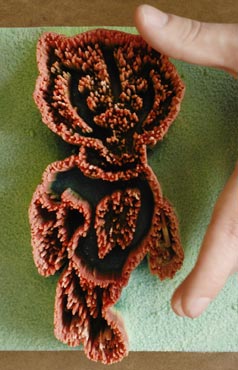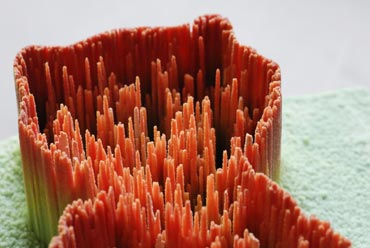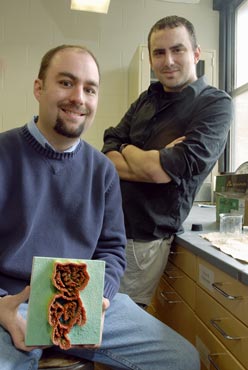
Caption:
An enlarged, 3-D model of "NanoBucky," a nanoscale version of the University of Wisconsin-Madison mascot Bucky Badger made entirely from tiny carbon nanofiber "hairs." To create the 3-D model, Mohammed Farhoud, a UW-Madison senior in biochemistry, converted the 2-D information contained in a scanning electron microscopy image of the original NanoBucky into 3-D, and then used these data to "print" the model in plaster with an engineering tool known as a rapid prototyping printer. The 3-D version is tens of thousands of times larger than the original NanoBucky -- 9,000 of which can fit on the head of a pin -- but still faithfully replicates the nanofibers composing the nano-mascot's structure.
Photo by: Aaron Mayes
Date: March 2007
300 DPI JPEG

Caption:
A close-up of the 3-D, plaster model of "NanoBucky" showing the individual carbon nanofibers that the structure is built from. Researcher Andrew Greenberg, education and outreach coordinator for the University of Wisconsin-Madison Nanoscale Science and Engineering Center (NSEC), and Mohammed Farhoud, a UW-Madison senior in biochemistry, are constructing models to allow visually impaired students to feel the nanofibers teaching these students about nanosurfaces and the construction of nanostructures.
Photo by: Aaron Mayes
Date: March 2007
300 DPI JPEG

Caption:
From left, Andrew Greenberg, education and outreach coordinator for the University of Wisconsin-Madison Nanoscale Science and Engineering Center (NSEC), and Mohammed Farhoud, a UW-Madison senior in biochemistry, pose with their enlarged, 3-D model of the nanoscale structure "NanoBucky." By giving blind and visually impaired students a chance to explore nanoscale surfaces with their hands, Greenberg hopes the models will help these students grasp nanoscience concepts and entice more of them to pursue science, technology and engineering.
Photo by: Aaron Mayes
Date: March 2007
300 DPI JPEG


